In Early November, a Maine ballot measure defeated a law legalizing gay marriage. It is clear that the Catholic Church, acting through 45 dioceses around the country, contributed substantial money to defeat gay marriage in Maine. According to the St. Louis Post-Dispatch, the St. Louis Archdiocese contributed $10,000.
Here in St. Louis, protesters have made themselves visible in a way that would likely irritate many Catholics and (see the comments to this article). The protesters have repeatedly stationed themselves prominently in front of the St. Louis Cathedral before, during and after the noontime Mass, in order to protest the $10,000 payment by the St. Louis Diocese to defeat gay marriage in Maine. Some of the St. Louis protesters have claimed that they were harassed by the police. See the following video they published.
I fully support gay marriage. And even though I don’t believe in a Divine Jesus, I can’t imagine Jesus, who purportedly opened up his heart to criminals and whores, taking active steps to keep gays from getting married. In my opinion, the Catholic Church, which has severely crippled its own moral authority, has acted out of bigotry in opposing gay marriage. On the other hand, I also think that the protesters need to be careful to pick their battles–there is no evidence that that the police were demanding anything of protesters who willingly stayed on the sidewalk while protesting. Only those who were standing in the street were asked to move (back onto the sidewalk). Even the protester shooting the video eventually moved back on the sidewalk where he was then apparently left alone to protest.
This protest did lead me to check to see whether there is an ordinance that would prevent a person from protesting while standing in the street in St. Louis. I found the following ordinance in a separate post describing the incident. Ordinance 17.16.270 (“Demonstration on or near street.”) provides as follows:
No person shall sell or offer for sale any goods or merchandise, display any sign or pictures, participate in or conduct an exhibition or demonstration, talk, sing or play music on any street or abutting premises, or alley in consequences of which there is such a gathering of persons or stopping of vehicles as to impede either pedestrians or vehicular traffic. (Ord. 57831 § 1 (part), 1979: 1960 C. § 827.280.)
Thus, this exchange between the protester and the police officer was in somewhat of a gray area painted by a statute, though the statute itself seems incredibly vague (despite the fact that enforcement of this ordinance was approved by a federal court of the Eastern District of Missouri in the unpublished 2008 decision of Apple of His Eye, Inc. v. City of Saint Louis, Mo. 2008 WL 2568268. Consider, on the other hand, that the only authority cited by the police officer at the protest (that people are required to obey the reasonable commands of a police officer) was embarrassingly thin, especially when First Amendment rights are at stake.
It seems that when one can protest perfectly well on a sidewalk, there is no compelling reason to pick a squabble with a police officer who tells you to get out of the street, even when he can’t correctly cite the relevant ordinance and even when a more relevant ordinance is terribly vague (despite being upheld by a federal court). I suspect that many protesters like the thought of getting arrested in order to stir up publicity. I wouldn’t recommend that tactic in this case, though, because the public would not get angry with the policy. Rather, they would wonder (as I did) why the protester didn’t simply get back on the sidewalk. They would think that the protester wanted to get arrested more than he wanted to protest.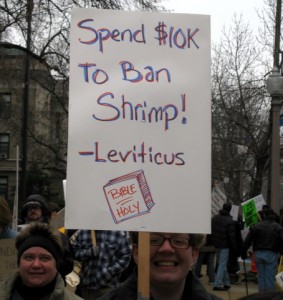
This incident also raises the topic of whether a church can keep it’s tax exemption when sending significant amounts of money to support a political issue. It is not clear how much money and energy a church can spend to further a legislative agenda. Current IRS regulations prohibit a church from spending more than a substantial part of its activities in furthering legislative changes. Here is the relevant IRS document; reviewing it will demonstrate that this is a convoluted topic.
In general, no organization, including a church, may qualify for IRC section 501(c)(3) status if a substantial part of its activities is attempting to influence legislation (commonly known as lobbying). An IRC section 501(c)(3) organization may engage in some lobbying, but too much lobbying activity risks loss of tax-exempt status.
What is a “substantial part”? It’s not clear, though “a few older court cases suggest that insubstantial lobbying would be something between 5 and 15 percent of the organization’s total activities.”
No church may take a position regarding a particular political candidate. If a church takes a position regarding a candidate, it could lose its tax-exempt status.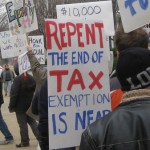
Many of the comments in the local paper argue that the Catholic Church has much better things to do with its money than promoting bigotry. I agree. How about aiding the sick and feeding the poor. The Catholic Church does a lot of good work in the St. Louis community–maybe it could do $10,000 more good work. Wouldn’t it be wonderful if the Catholic clergy, quite a few who are gay, would preach tolerance and even love from their pulpits?
The protesters plan to return to the St. Louis Cathedral tomorrow for one more protest at the Cathedral.


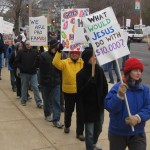
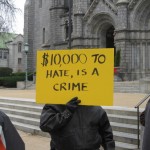

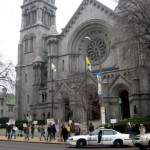
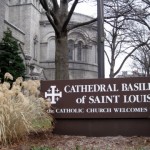
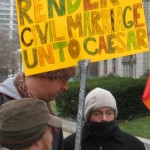
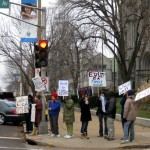
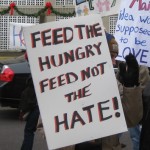
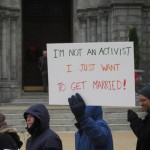
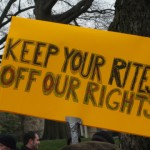




This is one of the reasons protestors (on any side of an issue) often run afoul of authority and subsequently lose some respect. What the cop understood perfectly well was that walking off the sidewalk, in the street, is intended to attract vehicular attention. People will slow down to see what's going on. Rubbernecking. Which in some situations can cause traffic problems. I know, I know, there didn't seem to be much traffic, but.
Protesters who know the law and hand out printed copies of the appropriate ordinances and permits to their members, can annoy authority but still establish their right to be where they are.
Often you see two completely different issues in conflict. (My right to wave my arms ends when the end of my arm comes in contact with the end of your nose, etc). It might be instructive to look at all the myriad protests like this that occur without any conflict with authority and see what's different.
This is the natural consequence of the Catholic Church bashing gays: http://www.irishcentral.com/news/Notre-Dame-uproa…
This is such a strange phenomenon, given the fact that so very many of the Catholic clergy are gay, apparently self-hating gays.
Your lifestyle is an abomination. http://i.imgur.com/Yb4aB.jpg
American conservative Christians should probably take some credit for a recent front page headline in Uganda:
"KAMPALA, Uganda — The front-page newspaper story featured a list of Uganda's 100 "top" homosexuals, with a bright yellow banner across it that read: "Hang Them." Alongside their photos were the men's names and addresses."
http://www.washingtonpost.com/wp-dyn/content/arti…
Amy Goodman examines the role of American Evangelicals in stirring up the anti-gay hatred in Uganda. http://www.democracynow.org/2010/10/21/anti_gay_f…